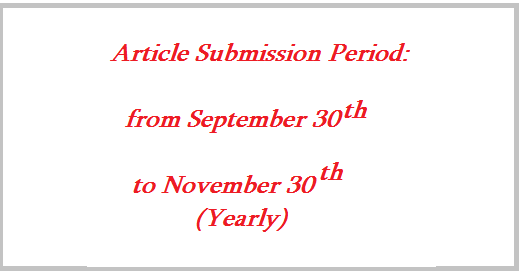The Peculiarities of Establishing the Georgian Correspondences of the Ancient Greek Meteorological Terminology (on the Example of Claudius Ptolemy's Works)
DOI: 10.55804/jtsuSPEKALI-18-13
Since time immemorial, people have been observing natural phenomena and changes in weather, because the practical experience has testified that fate of crops, success of seafaring and many other practical activities have depended on weather. The phenomenon of weather occupied a prominent place in ancient Greece: natural phenomena personified in the forms of deities were abundantly represented in ancient Greek mythology1. The examples of connection of gods and aspects of nature were richly presented in the beginnings of ancient Greek literature, namely, in the poems of Homer and Hesiod.
Along with depicting a natural phenomenon in mythopoetic ways, the practical necessity demanded a thorough observation of weather and its forecasting. Accordingly, even in Hesiod's poem "Works and Days" (the 8th century BC), we find the advice on the use of signs of nature for agriculture2. Traditionally, farmers and sailors were mainly interested in weather forecasting3. However, the interest in meteorology was not limited to a practical necessity. Due to their inquisitive nature, the Hellenes sought to perceive the world around them and to understand the harmonious wholeness of the cosmos. Therefore, the ancient Greeks were not only engaged in predicting natural events, but also in researching the causes of these events and determining their place in the general picture of the world. The achievements of the related disciplines, in particular, the mathematical astronomy, also contributed to the development of meteorology. Therefore, poets, philosophers, astronomers, astrologers and others were interested in this field.
Accordingly, the terminology related to weather and natural phenomena, which included artistic images, epithets of gods and specific meteorological terms, emerged in ancient Greek. The necessity of analyzing and harmonizing the mentioned terms in Georgian appeared during the translation of Ptolemy's "Tetrabiblos" or "Quadripartite".
Finding the appropriate Georgian equivalents of these terms is accompanied by the certain difficulties. The following can be distinguished among them: 1) cultural and ethnogeographic features: the ancient Greek meteorological terminology is shaped by the climatic specificity of the Mediterranean area. Exact matches of the Greek terms may not be found in another language; 2) homonymous and polysemantic concepts, which can be presented differently by various authors and in different contexts. Their exact definition necessitates understanding of the context; 3) vague concepts, whose exact meanings cause certain differences of scientists’ opinions.
Due to the volume of the material, it is impossible to fully reflect in one paper all the nuances of transferring the mentioned terminology from ancient Greek to Georgian. Therefore, one author, namely, Claudius Ptolemy (Alexandria, the 2nd century) and his works - "Tetrabiblos" or "Quadripartite" (astrology), "Almagest" i.e. "Mathematical Composition" (astronomy), "The Phases of the Fixed Stars" (daily weather forecast) and “Geography” - are selected for the research. Taking into account the format of the article, the concepts denoting cloud, fog and nebula as well as wind and the peculiarities of determining their Georgian correspondence were selected from the research vocabulary.
Cloud, fog, nebula
In the ancient world, observation of clouds played a prominent role in weather forecasting. As McCartney mentions, none of the countless popular signs of weather were more reliable and widespread than that obtained from clouds [McCartney, 1929: 612]. Ancient Greek scholars drew inferences about weather on the basis of density, size, outline, location or trajectory of clouds. These kinds of observations required an appropriate vocabulary. It is interesting that the ancient Greek names related to clouds are mostly the words derived from the root -νεφ-, for instance, the word cloud itself - νέφος (néphos) and νεφέλη nephélē (if the latter is capitalized, it will denote the ancient Greek goddess of clouds). The search for the etymologies of these words leads to the old Indo-European root *nebh-l, which denotes a cloud [Beekes, 2009: 1012]. Not only the mentioned Greek words originated from this root, but also the lexical units of other Indo-European languages, for instance: Latin nubes and nebula, Russian nebo, German nebel, etc. (for a more extensive list, see Beekes, 2009: 1012). Accordingly, in various Indo-European languages, the words derived from the mentioned root denote the sky, cloud, fog, darkness and nebula (in astronomy). Such variations appear even within a single language and require a translator’s observation and understanding of a context. I will show this on the example of Claudius Ptolemy.
Ptolemy offers us the following variants of words derived from the root -νεφ-: συννέφεια (sunnépheia), ἀνέφελος (anéphelos), νέφος (néphos), νεφέλιον (nephélion), νεφέλη (nephélē), νεφελοειδής (nepheloeidḗs). The Georgian equivalents of some of these words require consideration of a context and relationship with other concepts.
Firstly, I will discuss the concept that Ptolemy uses with the meaning of a cloud. This is νέφος (néphos). In ancient Greek, it has several meanings (it is translated as a cloud, a pile of clouds) [LSJ, 1940: lsj.gr], while figuratively it means a cloud, a shadow and even a clap of thunder [Giorgobiani, 2019: 278]. Ptolemy uses the mentioned noun four times in "Quadripartite" (twice separately and twice in the word-combination παρήλια νέφη (parḗlia néphē)) and once in "Almagest", with the sense of a cloud. In the seventh chapter of the first book of “Almagest”, Ptolemy mentions the cloud νέφος (néphos) and the shadow cast by it on the earth [Ptol. Almag. H 1984: 25]. In "Quadripartite" we find the same word in the context of weather forecasting: or if [the sun] has on one side the so-called clouds [παρήλια νέφη (parḗlia néphē)] of the false sun (parhelium), or if it is covered with yellowish clouds [νεφῶν (nephōn)] and long rays seemingly come from it, this fact indicates to strong winds [Ptol. Tetr. Hub., 1998: 159]. I preferred to present the word-combination παρήλια νέφη (parḗlia néphē) as the Georgian ცრუ მზის ღრუბელი/tsru mzis ghrubeli (the cloud of the false sun). Ancient Greek-Georgian Dictionary translates the word παρήλιος (parḗlios) as მაცდური მზე/matsduri mze (the tempting sun) [Giorgobiani, 2019: 339]. However, since the phenomenon that appears in the sky as a bright spot on one or both sides of the solar disc is known in modern Georgian literary and scientific language as პარჰელიუმი/parheliumi i.e. ცრუ მზე/stru mze - the false sun (see Dictionary of Foreign Words: პარჰელიუმი [Tchabashvili, 1989: 372]), it is better to translate παρήλιος (parḗlios) as ცრუ მზე , while παρήλια νέφη (parḗlia néphē) should be translated as ცრუ მზის ღრუბლები/tsru mzis ghrublebi (the clouds of the false sun). However, the parallel form - პარჰელიუმის ღრუბლები/parheliumis ghrublebi (parhelium clouds) - can be also used, because the term პარჰელიუმი/parheliumi, which is established in the Georgian language is the Latinized form of the ancient Greek parhelion.
As for the other names derived from the root -νέφ-, ἀνέφελος (anéphelos) occurs only once in "Quadripartite", while the word συννέφεια (sunnépheia), which has an opposite meaning, occurs twice. The adjective ανέφελος (anéphelos) is generally translated as უღრუბლო/ughrublo (cloudless), ღრუბლებით დაუფარავი/ghrublebit dauparavi (not covered with clouds) [LSJ, 1940: lsj.gr]. From these meanings, უღრუბლო can only be said about the sky. However, Ptolemy uses it in the context with the sun: ...when the sun rises or sets ἀνέφελος (anéphelos) uncovered by clouds... [Ptol. Tetr. Hub., 1998: 159]. In this case, ἀνέφελος (anéphelos) should not be rendered as უღრუბლო. It should be translated as ღრუბლებით დაუფარავი/ghrublebit dauparavi or as დაუღრუბლავი/daughrublavi. The noun συννέφεια (sunnépheia) (comp. the verb συννεφέω sunnephéō - I gather the clouds) implies the gathering of clouds, cloudiness, the cloudy sky [LSJ, 1940: lsj.gr]. This word is used by Ptolemy in the sense of the weather condition - the planet Saturn causes συννέφεια (sunnépheia), i.e. cloudiness [Ptol. Tetr. Hub., 1998: 137]. In the second case, συννέφεια (sunnépheia) is a possible accompanying factor of sunrise and sunset. Accordingly, μετὰ συννεφείας (metà sunnepheías) can be translated as ღრუბლების თანხლებით/ghrublebis tankhlebit (accompanied by clouds) [Ptol. Tetr. Hub., 1998: 159].
In "Tetrabiblos" as well as in "Almagest" Ptolemy often uses the adjective νεφελοειδής (nepheloeidḗs) (νεφέλη (nephélē) - cloud, εἶδος (eĩdos) - face), which can be rendered as ღრუბლის მსგავსი/ghrublis msgavsi (nebulous), ღრუბლისებრი/ghrublisebri (nebulous) (ღრუბლის მსგავსი [Giorgobiani, 2019 : 278]). This term is mainly used in astronomy by such authors as Ptolemy and Hipparchus (see Montanari, 2015: 1393). It is noteworthy that Ptolemy never uses this adjective in the context of terrestrial and atmospheric phenomena, but only in connection with stars and constellations. At the same time, νεφελοειδής (nepheloeidḗs) never stands alone, but always appears as a modifier of συστροφή (sustrophḗ) (heap, gathering [LSJ, 1940: lsj.gr]. According to Liddle-Scott's Ancient Greek-English Dictionary, these modifier and modified are translated as nebula [LSJ, 1940: lsj.gr], although in case of Ptolemy it would be more accurate to match them with ვარსკვლავთგროვა/varskvlavtgrova (cluster of stars) or ვარსკვლავური ღრუბელი/varskvlavuri ghrubeli (star-like cloud). As for nebula, Ptolemy presents the separate term for it - νεφέλιον (nephélion)4.
The primary meaning of the noun νεφέλιον (nephélion) is a small cloud, since it is a diminutive form of the word cloud - νεφέλη (nephélē) (though not always categorically diminutive [see Sider... 2007: 249]). It is used in this sense in many meteorological texts. For example, according to Theophrastus, a small cloud in the valley of Mount Hymettus brings rain [Sider... 2007: 71, 137].
Unlike the aforementioned meteorologists, the ancient astronomers used the term νεφέλιον (nephélion) to convey the meaning nebula. In "Tetrabiblos" as well as in "Almagest" Ptolemy uses this word only in the sense of nebula (not in the sense of a cloud or a small cloud). For example: ...the star called Asellus among those surrounding the nebula in Cancer... [Ptol. Almag. H 1984: 387], etc. The noun νεφέλη (nephélē) is used once in "Almagest": τις ὡσεὶ νεφέλη (tis hōseì nephélē) with some kind of a cloud [Ptol. Almag. H 1984: 177]. In this case, it is spoken about the cloud in the constellation, not in the atmosphere. Accordingly, its content approaches the implication of νεφέλιον (nephélion).
Ptolemy also uses separate terms for denoting mist and haze: ὀμίχλη (omíkhlē) - mist, haze („The Phases“), ὀμιχλώδης (omikhlṓdēs) (the same as ὀμιχλοειδής) - misty ("The Phases") and ("Tetrabiblos"), ἀχλυώδης (akhluṓdēs) - misty, hazy ("Tetrabiblos"). Ptolemy continues the tradition established by Aristotle. He makes distinction between the concepts of cloud and fog, although he uses the concepts denoting fog in a synonymous sense. This is logical, because in ancient Greece there was no difference between the words denoting fog (similarly to today’s English mist and fog).
As we can see, Ptolemy uses different concepts for denoting fog, cloud and nebula and faithfully follows this trend of differences in his works. During translation, it is advisable to preserve these differences for avoiding confusion of the concepts.
Winds and their names
Winds and their forecasting had a special importance for agriculture and seafaring. However, in the ancient meteorology, winds were presented not only as a target of forecasting, but as the means. Taub notes that ancient scholars considered winds to be a cause of a seismic activity [Taub, 2003: 148]. In addition, knowledge of winds helped the ancient Greeks in orientation during their travels: segments of a horizon were naturally associated with a wind, which had its own name in ancient Greek. This name corresponded to a personified deity of a wind. Often in a text, a name of deity was written with a capital letter and a name of a corresponding wind was written with a small letter.
Accordingly, a translator faces the dilemma - should he/she translate the names of the winds from Greek into Georgian or transliterate them? For example, should Βορέας (Boréas) be rendered as "northerly wind" or as ბორეასი/Boreasi?
My, as a translator’s, attitude towards the issue is the following:
1. I do not consider it appropriate to convey the mentioned names into Georgian by using the names of the respective parts of the horizon, because all the authors of the ancient times did not follow a single scheme of directions of winds. For example: for some authors, Boreas corresponded to the north direction (N), for others (including Ptolemy) - to the north-northeast (NNE);
2. In the Georgian language exists a long tradition of transliteration of the ancient Greek names of winds. For example, Sulkhan-Saba Orbeliani offered the "Georgianized" versions of the names of the ancient Greek winds. He presented Βορέας (Boréas) as ბორიასი/Boriasi, etc. (For the names of the winds, see Orbeliani, 1993... 213-216);
3. Accordingly, Georgianization" of the ancient Greek names of winds is not alien for the Georgian language. Therefore, I believe that the transliteration of these names is more justified. Hence, the rules of transfer of ancient names into Georgian should be taken into account (see Tonia, 2023: 17-24). At the same time, I think that (considering the peculiarity mentioned in the first paragraph) it is necessary to indicate directions of winds as notes.
Considering these principles, Ptolemy's twelve-wind system can be translated into Georgian in the following way:
Four cardinal winds:
Ἀπαρκτίας (Aparktías) - აპარკტიასი (northerly wind); "Geogr.", "The Phas."
Νότος (Nótos)6 - ნოტოსი (southerly wind); "Geogr.", „Tetr.”, "The Phas."
Ζέφυρος (Zéphuros) - ზეფიროსი (westerly wind); „Tetr.”, "The Phas."
Ἀπηλιώτης (Apēliṓtēs) - აპელიოტესი (easterly wind); "Geogr.", „Tetr.”, "The Phas."
Eight intercardinal winds:
Καικίας (Kaikías) - კაიკიასი (northeasterly wind). Ptolemy does not mention this wind by name, although the wind of the mentioned direction is included in his map of winds (see Berggren... 2000: 15).
Εὖρος (Eũros) - ევროსი (southeasterly wind) "Geogr.", "The Phas."
Λίψ (Líps) - ლიფსი (southwesterly wind) "Geogr.", "The Phas."
Ἰᾶπυξ (Iãpyx) - იაპიქსი (northwesterly wind) "Geogr."
Βορέας (Boréas) - ბორეასი (northerly-northeasterly wind) "Geogr.", „Tetr.“, "The Phas."
Θρασκίας (Thraskías) - თრასკიასი (northerly-northwesterly wind) "Geogr."
Λιβόνοτος (Libónotos) - ლიბონოტოსი (southerly-southwesterly wind) "Geogr.", „Tetr.“ Εὐρόνοτος (Eurónotos) - ევრონოტოსი (southerly-southeasterly wind) (see Berggren... 2000: 15).
In addition to the mentioned main winds, "The Phases of the Fixed Stars" and "Tetrabiblos" present the names of different seasonal winds, which are typical for the climatic conditions of the Mediterranean area.
χελιδονίας (khelidonías) - this wind is based on the word χελιδών (khelidṓn), which means swallow. Brill's Dictionary defines it as: the spring wind, which brings swallows [Montanari, 2015: 2353]. This name of the wind is the phenomenon characteristic of Hellenic culture. For this reason, for the clarification of the semantics, I choose მერცხლის ქარი/mertskhlis kari (wind of a swallow) as a Georgian match.
Similar to this wind is ὀρνιθίας (ornithías), whose root includes ὄρνις (órnis), which means bird. This is also a kind of an annual spring wind, which brings birds. Accordingly, it can be rendered as ფრინველის ქარი/prinvelis kari (wind of a bird).
ἐτησίαι are periodic winds that blow from the north-west during summer. The root of this name includes ἔτος (étos), which means year. This name is presented in plural and an exact Georgian match cannot be found. Accordingly, I believe that its Georgian version - ეტესიები/etesiebi - proposed by Giorgobiani is correct [Giorgobiani 2019: 161].
I believe that the analysis of the above terms indicates to the following:
a) It is easy to determine Georgian equivalents of some meteorological terms, because they do not contain ambiguity and exact analogues can be found in Georgian;
b) Transferring some names (for example, the names of the winds) is better through transliteration, especially if the tradition of their transfer and Georgianization exists. In addition to this, there are some specific terms, whose Georgian equivalents do not exist. It is important to follow the principles of rendering ancient names into Georgian during their transliteration (see Tonya, 2023);
c) There are homonymous and polysemantic concepts. While searching for their Georgian matches, a context should be taken into account.
Ancient Greek and Georgian are rich with concepts related to weather and natural phenomena. Moreover, in antiquity, the concept "meteorology" included not only what meteorology means in modernity, but also the geological and seismological phenomena. The discussion of meteorological terms cannot be fully presented in one article. Therefore, in the future the topic presented in the article can be expanded in two directions: 1) adding different Greek authors and analyzing the specifics of the terms used by them; 2) adding terminology related to the same field, which was translated into Georgian and had been used by authors of the classical and Byzantine eras; determining their place in the Georgian tradition.
Notes:
1. Supreme deity Zeus is simultaneously a god of the heavens, who rules clouds and lightning. His brother, Poseidon, is a ruler of the elements of water and is simultaneously responsible for earthquakes. Zeus's wife - Hera - is also credited with the ability to control weather. Next to the main gods, there are many minor deities - the personifications of different natural forces or seasonal events - in the Greek pantheon.
2. As Taub explains, the mentioned poem stands at the head of the distinguished tradition of the astrometeorological texts that relate astronomical events to seasons and weather [Taub, 2003: 7].
3. As a result of the research of the ancient meteorological texts, Sider and Brunshon distinguish people of other professions, which are addressees of weather forecasting, namely: millers, shepherds of various kinds of herds, military strategists, fishermen, merchants and to some extent, doctors [Sider... 2007: 1, sc. 1].
4. If we look through the English translation of “Almagest”, we will see that Toomer renders νεφέλιον (nephélion) as nebula and νεφελοειδής (nepheloeidḗs) συστροφή (sustrophḗ) as nebulous mass or globular cluster/ galactic cluster (if one bright star is meant) [Toomer, 1984: 16, 324, etc.].
5. Those works of Ptolemy are named, which mention the names of different winds.
6. The mentioned wind was considered as fruitful and moisture- bringing. Comp. Georgian ნოტიო/notio (humid).
References
| Giorgobiani T. 2019 |
Ancient Greek-Georgian dictionary. Tbilisi. |
| Orbeliani S. 1993 |
Georgian dictionary. Tbilisi. |
| Tonia N. 2023 |
Orthographic dictionary of the Greek and Roman proper names. Tbilisi. |
| Tchabashvili M. 1989 |
Dictionary of foreign words. Tbilisi. |
| Beekes R. 2009 |
Etymological Dictionary of Greek (Leiden Indo-European Etymological Dictionary Series; 10), vol. II. Boston: Brill. |
| Berggren, J. L. and A. Jones. 2000 |
Ptolemy’s Geography: An Annotated Translation of the Theoretical Chapters. Princeton, NJ/Oxford. |
| LSJ 1940 |
lsj.gr |
| McCartney E. S. 1929 |
Clouds, Rainbows, Weather Galls, Comets, and Earthquakes as Weather Prophets in Greek and Latin Writers. The Classical Weekly, 23(1), 2–8. |
| Ptolemy. 1954 |
Claudii Ptolemaei Opera quae exstant omnia: pars 1. Apotelesmatika. (Original work published ca. 168) |
| Taub L. 2003 |
Ancient Meteorology. New York; London. |
| Toomer G. 1984 |
Ptolemy Syntaxis Mathematica trans. |
| Sider D., Brunschön, C.W 2007 |
Theophrastus of Eresus: On Weather Signs. |













